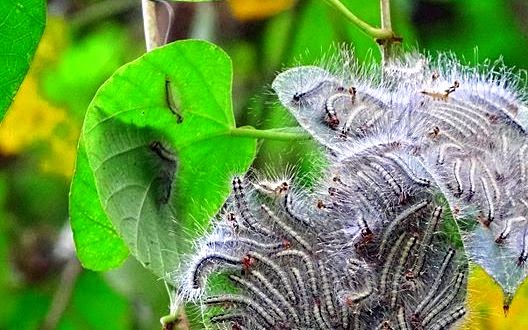 |
| An apology of Canadians riots in Vancouver after the Canucks win the Stanley Cup in 2011 (see why that doesn't work?) (courtesy of Creative Commons licensor Elopde) |
The way in which English most differs from Japanese and Chinese, however, is how English-speakers create new ways of counting and measuring for both practical and facetious purposes. Lehrer thus interprets a Mayflower of Americans (coined by New Zealand-born British lexicographer Eric Partridge in 1942) as a measure classifier. She notes that Mayflower refers to a ship, and a ship is a species of container. Presumably Lehrer means to say that phrase is the semantic equivalent of a "shipful" of Americans. A pound of Englishmen and a pint of Irishmen (both going back to at least 1969) are also measure classifiers. Lehrer similarly calls the pun "a column of journalists" an arrangement classifier constructed in the same way as a row of beans.
By contrast, she qualifies phrases such as "a bear of a man" (that is "a man who is in some sense like a bear") as metaphorical comparisons, and suggests that their use as collective nouns might be confusing. That is, a fraud of Freudians or a rejection of editors (or even a disworship of Scots, the only national collective noun in the Book of St. Albans) could easily be interpreted as a "fraud by Freudians" or "rejection by editors." This may or may not be the case, but all the same this observation allows these sorts of classifiers to be easily identified.
Collective terms for Canadians go back neither to the 15th century books on the medieval hunt nor even to mid-20th century lexicographies. They are of much more recent coinage, and of questionable utility:
1. An uncertainty of Canadians. One is apt to call this a measure classifier by analogy with the uncertainty principle in quantum mechanics; that is, the limit beyond which we cannot determine any definitive about a subatomic particle's physical properties. Why this term, which dates from no later than 2010, refers to Canadians is not immediately apparent, but perhaps only makes sense by comparison to their southern (and western) neighbors. Americans, the stereotype goes and making no assessment of its accuracy, are assured of the moral superiority of their country, its history and motives; Canadians are by turns cautious, polite and wish to avoid confrontation. Number of internet occurrences: One.
2. A divergence of Canadians. This goes back to at least 2004. Divergence, as a term in vector calculus, might best be described as an arrangement classifier. With no obvious meaning, a number of possibilities suggest themselves: the divide between English and French Canada, between the resource-rich Western provinces and the always-struggling Maritimes, between the populated south and the empty north; perhaps it refers to Canadian multicultralism generally, or to all of these. Number of internet occurrences: 36.
3. A mediocrity of Canadians. This phrase from 2007 is constructed along the lines of a disworship of Scots and is thus best qualified as a metaphorical comparison. The term does not admit an obvious meaning. Depending on one's politics, it might refer to Canada's environmental policies, its healthcare system, its sports teams or Nickelback, leaving aside the accuracy of those claims. Number of internet occurrences: One (albeit misspelled).
4. A puck of Canadians. This term from no later than 2012 does not fit nicely within Lehrer's typology; presumably the creator of this neologism wants us to think of hockey and thus of Canadians. One could interpret puck as a synecdoche for hockey (or as a metonymy for hockey player) which would put this in the realm of a metaphorical comparison. The association between hockey and Canadians is too obvious to explore in detail. Number of internet occurrences: One.
5. An apology of Canadians. To the extent this could be confused with an "apology by Canadians," this is that Lehrer would term a metaphorical comparison. Though heard on the CBC and read in the pages of the New York Times, the first instance in the media appears to go back to the Toronto Globe and Mail in 2003. Former NPR ombudsman and Alberta native Jeffrey Dvorkin has performed yeoman's work in disseminating the term, starting in the Globe and Mail in 2003, again in 2008, and most recently in the Times. In a 2013 letter to the Times, Dvorkin defended Canadians' hono[u]r against the English, asserting the latter had no right to the title of the "sorriest" people on earth in light of the collective noun "an apology of Canadians." That said, Dvorkin has called this name of assembly a "joke." Perhaps so. Perhaps not.
Dvorkin's argument for the noun of assembly "apology" seems to be based on behavior of Canadians; specifically, their use of the term "sorry" in daily life and the connection of this linguistic tic to Canada's general reputation as a polite and civil country. Others suggest Dvorkin is wrong, arguing that Canadians say "sorry" frequently but rarely apologize. It remains possible that "apology" resonates at a less personal and more societal level: legislation in several provinces protects individuals who apologize after accidents from having these "expressions of sorrow or regret" used against them in latter civil suits. Similarly, the decades' long controversy regarding abuses in Canada's residential schools for First Nations children likewise prompted institutional apologies over many years starting with the Anglican Church of Canada in 1993, followed by the Royal Canadian Mounted Police in 2004, then Primer Minister Stephen Harper on behalf of the sitting cabinet in 2008; the process included establishment of a Truth and Reconciliation Commission, a 1998 Statement of Reconciliation and, in 2005, a $1.9 billion compensation package. Individual students at these schools were awarded a "Common Experience Payment" of $10,000 for their first year residing at such a school, and $3,000 for each year thereafter, though individuals could opt out of this process and proceed individually on their claims.
By contrast, the Federal Government refused to apologize for the forced relocation of Inuit families from northern Quebec to the High Arctic; specifically, to Ellesmere Island in Northwest Territories (among the coldest inhabited places on the planet). The Canadian Human Rights Commission found that the motivating factor was merely the assertion of Canadian sovereignty in the High Arctic by establishing permanent communities there and not the well-being of these Inuit families. Though the House of Commons standing committee on Aboriginal Affairs in 1991 requested an apology from the Government of Canada, none was forthcoming. However, in 1996, a $10 million trust fund was created on behalf of the forcibly relocated people and a "Reconciliation Agreement" was signed.
Finally, in 1996, the Government of Canada apologized to Japanese-Canadians detained in internment camps during World War II. One month after a similar program was initiated in the United States, survivors of the camps in Canada were granted compensation in the amount of $23,000 per person. Number of internet occurrences: 1,090.
6. An eh of Canadians. Occasionally this is styled an "eh?" of Canadians. Again this falls into the category of a metonymy, of Canadians generally, and of rural "hoser" Canadians, particularly within Canada. The term is used more in imitation of Canadians than by them, as terms that are its semantic equivalent (right, huh, you know, etc.) are in fact used more often (at least in studies of Toronto English). As such it constitutes a metaphorical comparison, first appearing no later than 2002. Number of internet occurrences: 234.
None of these terms is particularly appealing. Those with only one occurrence require no prolonged dismissal. An eh of Canadians appears more inspired by Americans watching SCTV or South Park than anything native to Canada; divergence and apology both are based on extended jokes. Let us turn to some alternatives:
7-11. By analogy with Mayflower, we might look at crucial moments in Canada's history for collective terms: a patriation for the return of the Constitution in 1982, a Don de Dieu for the lead ship that brought the first settlers from France to what is now Quebec City in 1608, a loyalty (or perhaps, a troth) for the United Empire Loyalists who were evacuated in 1783 from the thirteen colonies to British North America after the American Revolution. Most promising, however, might be a confederation of Canadians harkening back to the confederation of Upper Canada (Ontario), Lower Canada (Quebec), New Brunswick and Nova Scotia as the Dominion of Canada in 1867. Confederation benefits by alliteration, but also constitutes an arrangement classifier (it describes how the provinces relate to one another) and a metaphorical comparison by means of synecdoche (describing Canadians as confederates-- veritable brothers and sisters-- within a larger body). It could be styled "a/une confédération of/de Canadiæns" were anyone ever so inclined.
12-13. Less political terms might also serve-- a poutine of Canadians, a KD of Canadians. The former is better known outside of Canada, the latter-- short for Kraft Dinner or what elsewhere is known as Kraft Macaroni and Cheese-- might be even more important within Canada where it has been called the "national dish." Both could be said to be measure classifiers to the extent they are elliptical for "a[n order of] poutine" and "a [serving of] macaroni and cheese" respectively. Poutine has the benefit of being the same word in Canada's two official languages, English and French.
14-16. Poutine, though a dish that is consumed throughout Canada, originated in Quebec, and thus is worthy of consideration as a collective name for that region: A poutine of French Canadians. Recalling the ship that brought the first permanent French settlers to Quebec City, translation to English would give us a God's gift of French Canadians, which enjoys an undeniable je ne sais quoi placing it above other possibilities (and which like Mayflower is ultimately a measure classifier). Some may enjoy other terms that could be used equally in English and French: a bloc of Québécois, a habitation of French Canadians, though these could be obscure outside Canada.
Readers are invited to leave their opinions and observations, identify terms they like and why, and suggest their own if they are so inclined. Readers should of course identify from where they hail.



